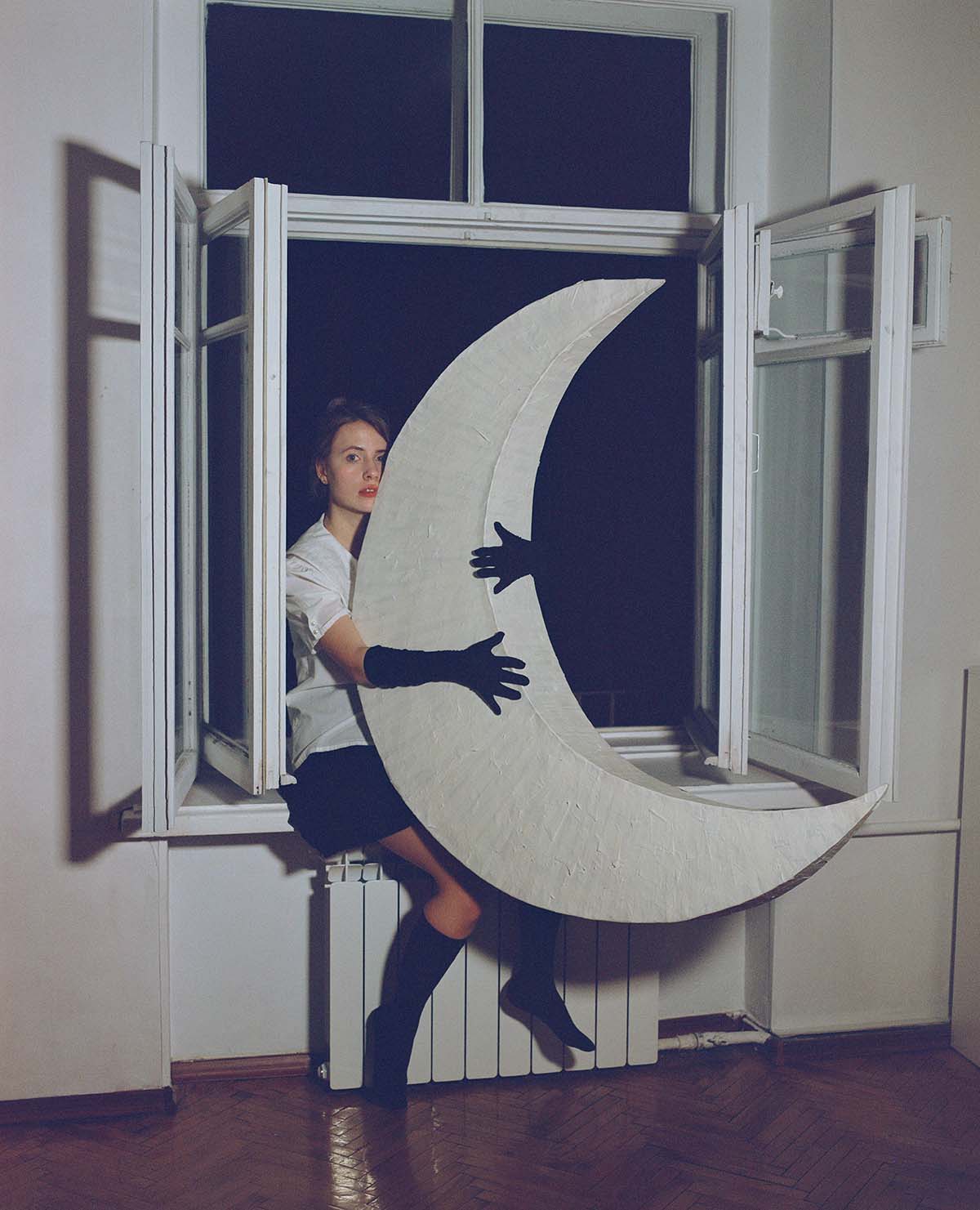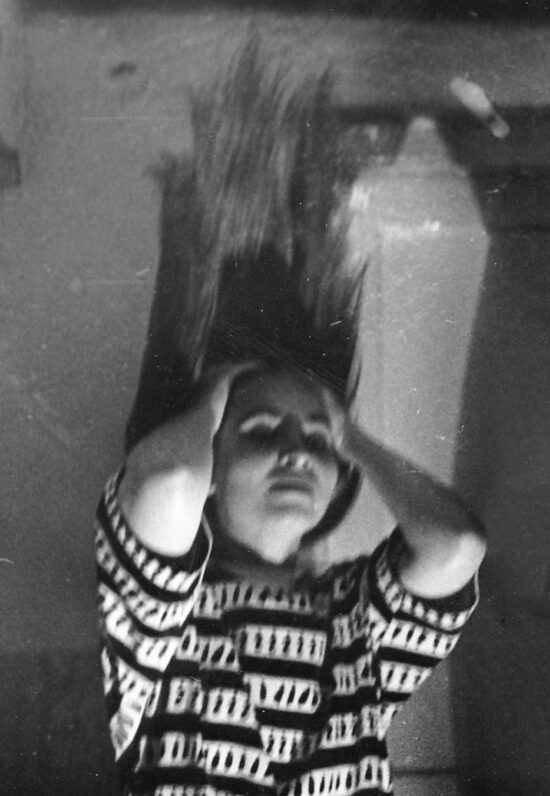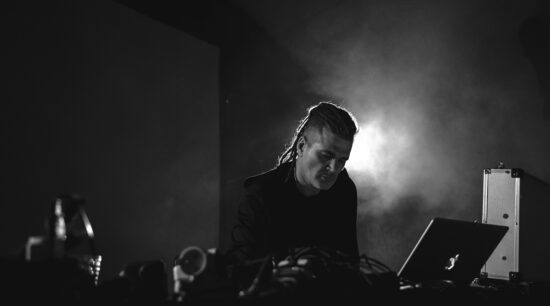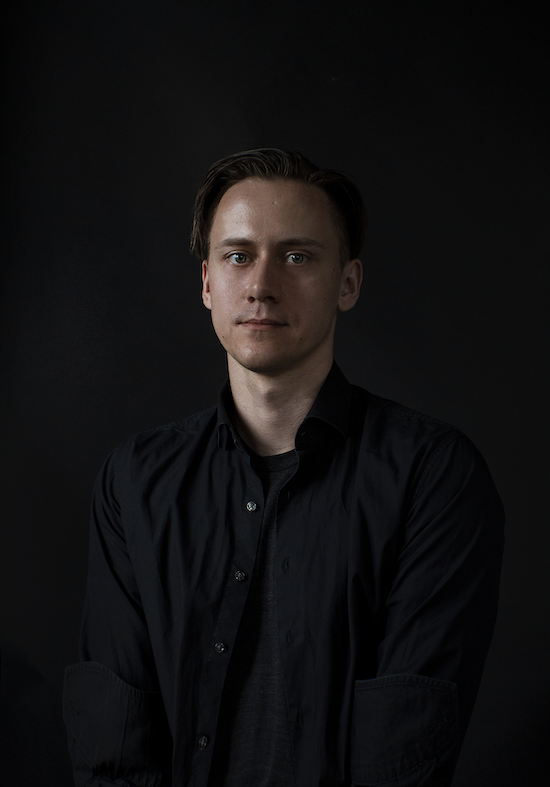– Victor Pivovarov works about Moscow describe the reality, routine and ordinary life, but at the same there’s something very strange about his paintings. There’s a pencil, and there’s a house and a tree on it. It’s the same with Sailor Moon – those girls are living their ordinary lives, going to school, doing all the homework, but at the same time they defend the world against violence from other planets. This is the point where Pivovarov, Sailor Moon and fairy tales from the 70s and 80s meet in the same approach. They come together in my music – says singer and composer, Kate NV.
Translation: Aleksandra Szkudłapska
Kate NV is the author of one of 2020’s most hit albums. Room for the Moon, released by RVNG Intl, is an intriguing journey into childhood, full of synthesizer sounds and surreal lyrics. Above all, however, on it Ekaterina Shilonosova shows her great sense for making alternative pop that navigates between captivating melodies, interesting arrangements and an atmospheric ambience. After Binasu and Для = For, the artist combines the two paths present on these albums – structured songs and ambient passages based on a Buchla synthesizer – which results in a hit album, warm in sound, but also with radio potential, despite the fact that Kate NV keeps her character, and stays far from the mainstream. As I wrote about this release, it is a return to fairy tales and memories from the 70s and 80s, Russian conceptualism, Socialist Realist or surrealist reality. There is a pop lightness here, guitar parts as if taken from prog-rock, post-punk twists in the style of David Byrne, and the atmosphere of Japanese fairy tales. It is an album immersed with one foot in avant-pop and the other in the aesthetics of the Russian borderland; it brings to mind fairy-tale soundtracks, but is perfect for radio airplay.
This release is an opportunity for a broader conversation about Kate NV’s music. It is also a pretext to ask about her other fields of activity: the more experimental ones, such as the Moscow Scratch Orchestra and the amazing post-punk outfit Glintshake, which has just released Flexible Schedule, an album where they combine their fascinations with punk, art-rock, improvisations and Dadaist-inspired surrealism. Despite the pandemic of 2020, this is an active year for Shilonosova, and on a hot August afternoon, she managed to find time to talk about these activities – we went back in time to rummage through her inspirations, music education, and the influence of her native Kazan on her music, but we also spoke about looking for magic in everyday life, which is an inseparable element of her work. The result is the following conversation.
JAKUB KNERA: How did you start being interested in music?
EKATERINA SHILONOSOVA: I started talking when I was very young and I was already singing when I was two. I was mostly singing different songs using one note, but rhythmically everything was correct. When you’re singing a capella and don’t have any instruments, there is a pause between the chorus and the next verse. Usually everybody is trying to skip this part, especially when you’re singing too fast to save time. And when I was a kid, I was telling my parents not to make it shorter – it was probably then that my mom realized that at least I knew something about rhythm. That was when she thought for the first time that I could well be interested in music.
Did your parents encourage you to get deeper into art?
Mom gave me a lot of sheets of paper, watercolours, markers, pencils, and crayons. My dad used to play the guitar – he made songs for me about characters from fairy tales I was reading at the time. These were short, funny songs and we performed them together – he was playing the guitar and I was singing. That’s how it all started.
I started going to music school at seven. In Russia, music school is like a separate school, but the system is the same as in the ordinary school. You start going there at seven and finish around fifteen. The basic programme takes 8 years – I started as a piano player and then I switched to choir, because I was really into singing.
With many people who graduate from music school, when you study something for such a long period of time, and you’re fed up with all the rules and boundaries – at the end you start hating the whole system. But I realized that I actually love playing, singing and doing all this stuff. I don’t like theory and I’m very bad at that – music is a very mathematical thing. But I think I’m pretty good intuitionally. I realized that I want to have a band, play and compose songs. You get this level of freedom when you finish something and you are like “wow, now I can do anything I want” – it’s a very cool feeling.
When I graduated from ordinary school, I had a thought that if I failed in making music, I would probably become a music journalist. I wanted to write about music if I didn’t feel like doing it.
There is a theory that music journalists are simply not good enough to play music!
I think journalism is more about analysing stuff, searching and digging whereas music is also about searching. Being a journalist is very cool because you can put your eye outside the brackets and look at the system as a whole. When you’re in it, it’s sometimes hard to understand a process, but when you’re out and yet still in, you can bring it all together.
You were born in Kazan. Did this place have some impact on you in terms of music?
I’ve been thinking a lot about it recently. For the past few years people didn’t ask me where I’m from, but now they started asking me this. The fact I was raised in Kazan, in the Republic of Tatarstan, has influenced me a lot. This type of music was everywhere and I was studying a lot of Tatar composers, reading about their lives, and key pieces. Recently I’ve listened to a couple of music pieces by Tatar composers – it’s such beautiful music. I even thought of doing a mix of Tatar music for the radio. I love it and it represents my childhood – I like the way it’s very cheerful; even if it’s a sad song, it’s still in the major key and not minor one. People keep asking me why I make such cheerful music and why it’s all in major key – it’s because I was born in this kind of context. Culturally, Tatar people are very inspirational, nice, and cheerful, in Kazan they hug each other all the time and this is the sincerest thing, it’s not like everybody’s pretending, they are literally trying to give you some joy and sharing it with you. That’s the vibe I was raised in, I think I’m trying to rework it, use this vibe – it’s in my core, somewhere deep inside.
Does it have something in common with Japanese music on which you’re very focused?
I started thinking why the pentatonic scale is so interesting to me – it makes so much sense because of the location. I’ve never lived in Japan but I’m very comfortable listening to this kind of music – I realized that it’s because it transports me to my deep childhood in school, where I was raised listening to this kind of music. I’m not trying to say that Tatar music is very similar to Japanese or Chinese music, but there are some similarities, because they use the same scale and this music is very cheerful. Tatar singers used to wear beautiful clothes, they love nature, I think it just came to form my core in a way. When you grow up, you listen to everything that surrounds you. You just absorb information like a sponge, you memorize it when you listen to or watch something.
It’s a very cool question! It’s the same as with the pentatonic scale. It’s more about intuitionally going somewhere – for me, music is like a scientific project. The most important thing for me when making music is to be as sincere as possible at the moment when I’m making a track or song. Sometimes it feels like you reach some kind of memories or you get an emotional feeling coming from somewhere deep inside of your soul.
Is Room for the Moon like a return to the past in a way?
Aesthetically, most of the songs on my new album, Room for the Moon, in a way remind me of something I could definitely imagine, some kids’ movies from the 70s or 80s. They gave me this feeling of nostalgia, but at the same time it’s very warm too. If we’re talking about visual presentation, I was just trying to share this feeling that I have, the connection that I have with the songs – they are talking to my inner child. It’s not like I’m a creator, it’s my conversation with music. I perceive music as a persona – when you start to think about what my songs are, they are talking to my inner child and at the same time they came out of me. They remind me of my childhood and of myself as a kid. It’s like the feeling of being hugged, proving I’m not alone.
You said that when you were finishing Room for the Moon, you were super lonely.
I just had this feeling that I would always have contact to myself as a kid and it’s very important to remember those moments: when you were happy, when you were a kid, when everything was inspiring and magical all around you, even if it was something ordinary. It’s important to see magical stuff in simple things that surround you. I like a lot of these movies from the 70s and 80s and those TV shows and programmes, because they didn’t have CGA and computer graphics – people were using craft, doing something out of paper, sponge, etc., and everything looked so ridiculous. You saw that it was created by a human being – on the one hand, it wasn’t magical and on the other hand, it was. Everything becomes magical as soon as you believe it’s magical. And when you’re a kid and see a movie with an old witch wearing something made of paper, it’s still very magical. You can touch this magic. Nowadays 3D stuff feels so real, but it’s unreal at the same time – it’s not here, you cannot touch it, see it live in a museum, because it was made on a computer. As an architect, I’m doing 3D models all the time, but the problem is that you cannot touch them and I love things made by hand! They have this warmth inside, this kindness that you put into things when you create something, because you want to create. Human being always want to create something – that’s how art happened, there is the constant intention to create something, even if you make food and you want to make it look good. It’s a joyful time for you and your friends.
Is this real-unreal element important in Room for the Moon?
I really love this kind of aesthetics and wanted to show the connection between these songs and that kind of vibe. These videos are more like theatre, a TV show or programme – we create all the costumes together with a team. It’s an amazing feeling when you drew a costume and then it’s alive. We create everything using our hands, not on a computer. Look at this giant chair that you can see in my video “Marafon 15” – we preferred to create it by hand. Now it is standing in my room – I perceive it as a character, he’s a part of my world right now and I have to deal with it.
I think things are more magical when they’re real. This magic element is also in the title of your album. You used “room for the moon” not as a space, but as a part of the house. I like this childlike way of thinking.
The funny thing is that you can imagine this picture: a moon is sitting on a chair in the room. It’s very childish. But if you switch on your brain and start thinking that the moon is so big that if you sat next to it, you wouldn’t be able to see the walls, this is insane. The moon should be very huge, but this is how relative everything is in this world. If you put yourself, a small human being, next to a giant moon, you won’t be able see boundaries and the walls. There won’t be room for you, but there is a room for the moon, that’s really crazy. The moon is a magical thing and a very esoteric, important symbol – and it has a room, lives in an apartment, drinking tea at midnight, likes his carpet, and also needs a rest sometime (laughs). You can imagine this routine part of the life of the moon – it’s a truly endless story, you can think about it forever.
My first record, Binasu, was a kind of combination of ambient and pop songs. I started making songs for Room for the Moon a long time before I started working on Для = For, my second record. Actually, it happened as if by the way on Room for the moon. When I make music by myself, alone, it’s kind of unpredictable – I never know if it’s a track or a song. I guess that with my second album, I was at a time in my life when I realised that I didn’t want to sing that much. That’s why this record happened. Accidentally, I realised that I made an ambient record. But that was a moment when I got tired of improvising all the time and playing instruments – I desperately wanted to sing again and decided that I needed to finish these songs. It was a very physical moment – I was tired of sitting at the table and staring at my devices. I wanted to have a band and sing. I started most of these songs before Для = For and finished them after that, because that moment came.
The topic of singing is interesting – you sing in English, Russian and French. In your band Glintshake, you used to sing in English and you now sing in Russian. How important for you is to choose the language?
It’s the same approach as to making music in general. When you can tell it’s a song (laughs), you then start thinking how you are going to sing. All the languages are different, and this depends on the language: intonation, words, phonetics. It’s the same as choosing the instrument for the track – deciding if you want to use the clarinet or saxophone – or the patches generated by the synthesizer. The song tells you which language she wants to use.
When I finished “Marafon 15”, I started writing lyrics in English, but finally the track is in Russian because I asked my friend, who is also playing bass – we’ve known each other for ages – and he sent me the Word file with lyrics in Russian. It was basically the same. It was very interesting and proves that sometimes music tells you even more than you can understand. Languages are more like supportive instruments, an additional instrument, a layer to help listeners understand more. But I’m leaving enough space for imagination – all the lyrics are not on the records, it’s all quite abstract. Abstract lyrics are not telling someone what to do but asking questions and the way you respond to it shows you a different meaning too.
I like the first song on your new Glintshake album – if I can call it a song because it is 20 minutes long – because I can hear some similarities in Russian and Polish. I don’t speak Russian and would probably understand more in English, but I can catch some sentences and it’s more abstract then. We’re talking about your solo project, Glintshake which I just mentioned, Moscow Scratch Orchestra – how do you treat all of them? Are they complementary in a way?
A couple of years ago I used to think that it’s like I have three different personalities, but now I can definitely tell that it’s me everywhere, I’m one person and these are three different aspects of me. I listen to Taylor Swift and at the same time I can listen to Stockhausen, I can listen to Morton Feldman or I’m a huge fan of John Cage. These are the different aspects of me – people can listen to very different projects: Michael Jackson or Merzbow. Scratch Orchestra helped me to start perceiving the world and the music in a different way – before it, I used to lock myself in a box. This group was like opening the window to let fresh air in, what is very important. I guess I’m still learning how to be careful with sounds. When I’m working alone, I’m quite careful with putting sounds together – it’s like making a bouquet with different flowers and you make a very nice composition: each flower is beautiful separately, but they work all together beautifully.
It’s the same with Glintshake – we play altogether and jam a lot. The first track “Flexible Schedule” is a jam. We came to the rehearsal and were playing for twenty minutes straight. We added some flutes and vocals, but it is mainly recorded as a whole with no cuts. We changed the structure without even looking at each other. It’s more about listening and being careful with sounds – yours and those of the other players – and respect for the music. That connects everything together. If these different activities are very different – it’s a different bouquet of flowers, but it’s still flowers. I’m also a part of the process who helps to create this bouquet.
Glintshake is not only about me, there are three more people – we’re all different, coming from different backgrounds, and listening to different music. Glintshake is more an ironic exploration. We’re having a lot of fun witnessing the birth of music together, it’s more like team work, it’s more like a scientific project. Glintshake is a band of four different people trying to communicate with each other, having fun and loving the fact they’re making music together, exploring different aspects of our lives. We’re trying to explore ourselves and our music.
When you do not allow yourself to be yourself or you’re too strict with yourself, you become too unhappy. I had to learn it in Scratch Orchestra – before that I was too strict with myself and the music around. I used to think there is good and bad music. If I don’t like some music it’s not shitty – it’s just not my cup of tea. It works everywhere – regarding people, religion, gender. You have to learn to let everything be the way it is. I’m still learning as life is full of stereotypes – social pressure is huge and we are all raised in context where people divide everything into good and bad. It’s very hard to learn to start thinking how to open your heart and mind. I’m still learning, I’m trying my best to do so.
At the beginning you said that you’re not good at theory, but you’re saying how different aspects can work together. That reminds me of different inspirations for your solo project – Viktor Pivovarov on the one hand and Sailor Moon on the other hand. It works together.
It’s true! People contain lots of small bits of things they like, and you never know how it’s gonna work out in the end. You never know how those inspirations work together. From a further perspective it looks different, but from close-up one it’s kind of similar. Victor Pivovarov is very pure, honest and surreal at the same time – his works about Moscow describe the reality, routine and ordinary life, but at the same there’s something very strange about his paintings. There’s a pencil, and there’s a house and a tree on it – it’s like the “room for the moon” idea with something ordinary and magical at the same time: a house on a pencil. It’s the same with Sailor Moon – those girls are living their ordinary lives, going to school, doing all the homework, but at the same time they defend the world against violence from other planets. Ordinary life meets surrealist and magical life. You create something magical from something ordinary. This is the point where Pivovarov, Sailor Moon and fairy tales from the 70s and 80s meet in the same approach. They come together in my music.
Room for the Moon is out now via RVNG Intl. Read my review here.




